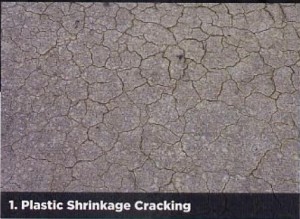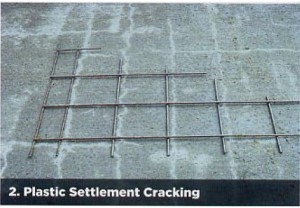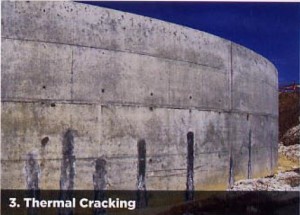Written by Paul Uno. Originally published in “Australian Concrete Construction” magazine, December 2011 edition.
Cracks in concrete are always a concern for both client and contractor. Since concrete first emerged over 2000 years ago, it has cracked when subjected to adverse conditions. The introduction of steel reinforcement did tend to assist in limiting the onset of cracking but this only really assisted crack control in hardened concrete.
Before concrete goes hard it is usually in its ‘plastic state’ (which means it can be
deformed without returning to its original shape). This article will focus on the cracks that develop in concrete whilst it is still in its plastic state.
The three most common forms of cracking that occur in concrete before it has reached its 28 day characteristic strength are called (1) Plastic Shrinkage Cracking (2) Plastic Settlement Cracking (3) Thermal Cracking.

Plastic Shrinkage Cracking occurs when the concrete loses its bleed water too quickly from its surface and therefore dries rapidly, which induces tensile stresses into the top layers of the freshly placed concrete. Since the concrete is still too weak to resist these stresses it cracks, usually seen as a random pattern (see photograph 1).
Methods have been developed by this author and others to predict the likelihood of this occurring eg by using evaporation formulas (see article in Australian Concrete Construction, February 2011 or go to http://www.etia.net.au/resources/evaporation-calculator)

Plastic Settlement Cracking can occur while the concrete is still settling. This happens when the concrete cover over the reinforcement is too small, or the mix contains too many fines or the mix is too slow in releasing its bleed water. This form of cracking is the easiest to identify as it reflects the location of the reinforcement (see photograph 2).

Thermal Cracking mainly occurs in thick members (usually greater than 300mm) and is due to too much heat building up in the concrete member as the cement hydrates and therefore heat makes the plastic concrete expand. However later when it cools down and tries to contract it is often restrained by other members and therefore cracks eg in walls over foundations (see photograph 3).
Over the past 30 years in this industry, Paul Uno has repeatedly seen these same problems occurring. He therefore conducts many courses that address cracking in concrete such as the Cement & Concrete Technology & Practice (2 day course); Concrete Repair and Protection (1 day course), Cracks in Concrete (1 day course).
Further information on the other courses conducted by Cement & Concrete Services
and various other technical articles and information on concrete can be found at
www.cementandconcrete.com.
Besides conducting concrete courses around Australia, Paul is also a part time senior lecturer at UNSW (Built Environment) and Sydney University (Civil Engineering) as well as the present chairman of Australian Standards committee BD-066 for Precast and Tilt Up (Prefabricated) Concrete.
